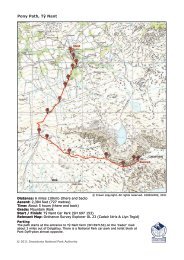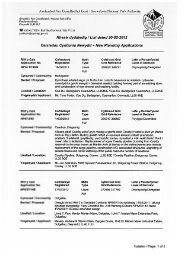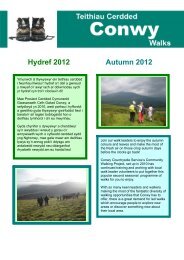You also want an ePaper? Increase the reach of your titles
YUMPU automatically turns print PDFs into web optimized ePapers that Google loves.
The Lobarion Community<br />
The following provides some guidance on <strong>the</strong> identification <strong>of</strong> <strong>the</strong> Lobarion lichen community. For fuller<br />
details see James, P.W., Hawksworth, D.L., & Rose, F. (1977) Lichen Communities in <strong>the</strong> British<br />
Isles pages 322-327 in Seward, M.R.D. (Ed.) (1977) Lich en Ecology, Academic Press,<br />
London.<br />
When well-developed this is a spectacular community that can include some <strong>of</strong> <strong>the</strong> largest foliose lichens.<br />
Unfortunately most <strong>of</strong> its constituent species are highly sensitive to suphur dioxide, acid rain and excessive<br />
ammonia levels and many examples <strong>of</strong> <strong>the</strong> Lobarion in Wales are now species poor.<br />
The Lobarion is likely to be present on a tree or shrub or any rock face that supports <strong>the</strong><br />
following:-<br />
Any species <strong>of</strong> <strong>the</strong> genera:<br />
Degelia Menegassia Parmeliella (except Parmeliella parvula – see below)<br />
Fuscopannaria Nephroma Psuedocyphellaria<br />
Heterodermia Pannaria Sticta<br />
Lobaria<br />
Any <strong>of</strong> <strong>the</strong> following species (*=species individually <strong>list</strong>ed in Section 42):<br />
Agonimia octospora Leptogium brebissonii* Phyllopsora rosei<br />
Collema fasciculare* Leptogium cochleatum* Porina coralloidea<br />
Collema furfuraceum Pachyphiale carneola Porina hibernica*<br />
Gyalecta flotowii* Parmotrema crinitum Punctelia reddenda<br />
Gomphillus calycioides Peltigera collina Thelopsis rubella<br />
Leptogium burgessii<br />
Any three <strong>of</strong> <strong>the</strong> following species:<br />
Acrocordia gemmata Leptogium lichenoides Opegrapha sorediifera<br />
Arthonia vinosa Leptogium teretiusculum Parmeliella parvula<br />
Catinaria atropurpurea Loxospora elatina Peltigera horizontalis<br />
Dimerella lutea Mycobilimbia pilularis Pertusaria hemisphaerica<br />
Normandina pulchella Thelotrema lepadinum<br />
Mine site community (Metallophytes).<br />
Once Wales probably supported a significant assemblage <strong>of</strong> lichens associated with natural outcrops <strong>of</strong><br />
heavy metal-rich rock. Due to <strong>the</strong> destruction <strong>of</strong> <strong>the</strong>se outcrops by our mining activities <strong>the</strong> survival <strong>of</strong><br />
metallophyte lichens are now almost entirely dependant upon <strong>the</strong> conservation <strong>of</strong> old mine sites.<br />
Two special types <strong>of</strong> lichens are almost completely confined to <strong>the</strong>se sites in Wales:-<br />
1. Obligate metallophytes. Those lichens that appear, in some way, to require heavy metals and only occur<br />
on heavy metal-rich substrates.<br />
2. Faculative metallophytes. Those lichens which can tolerate heavy metals, but can be found elsewhere in<br />
sites, without such heavy metals. Most <strong>of</strong> <strong>the</strong>se species are probably poor competitors but can survive<br />
14






